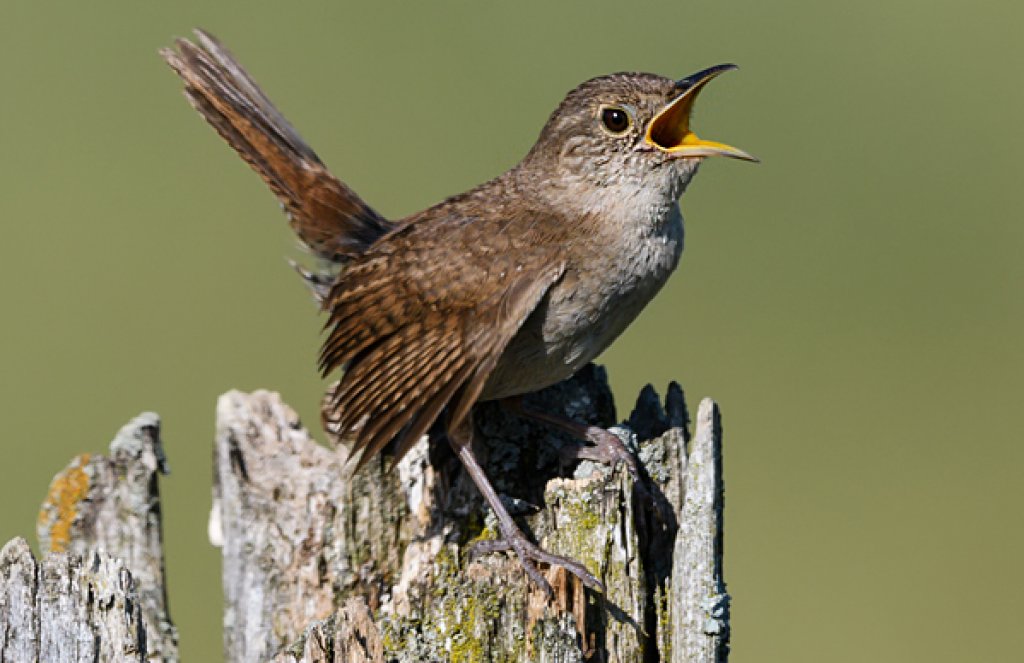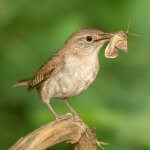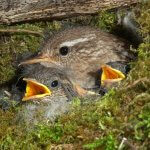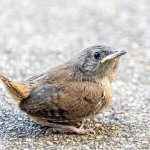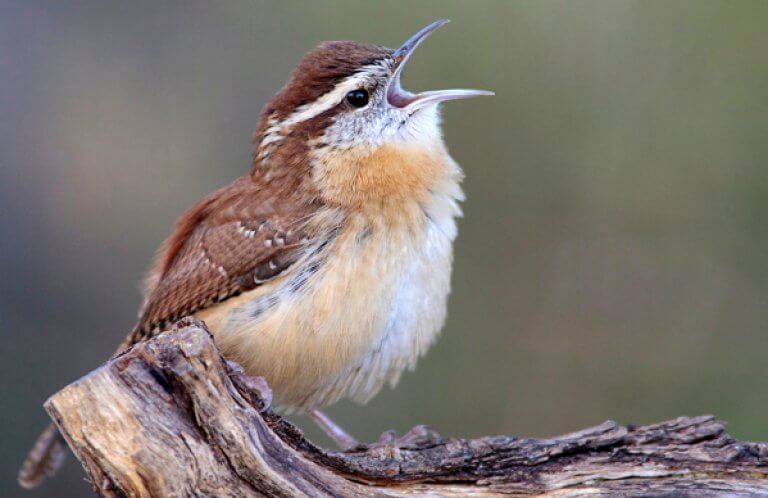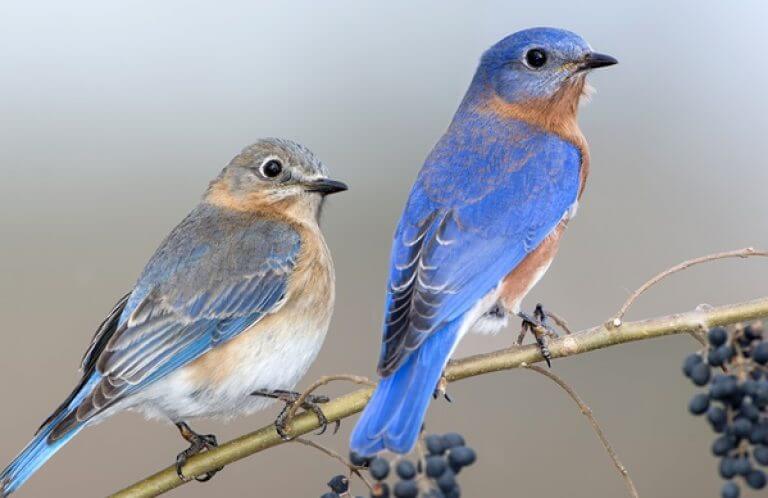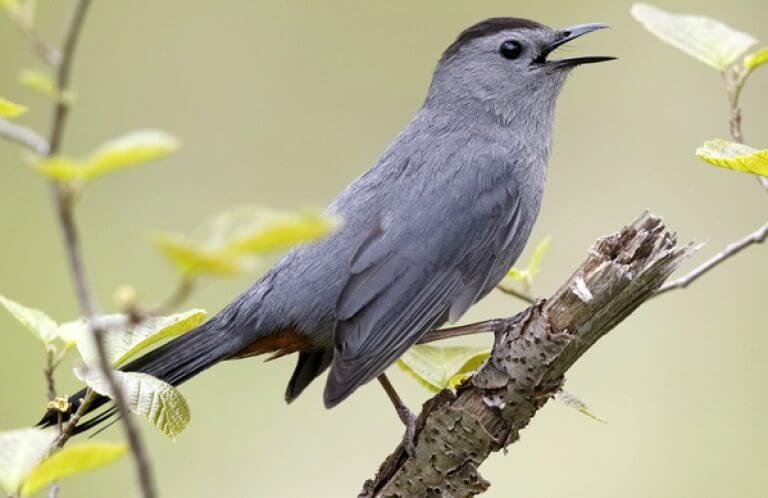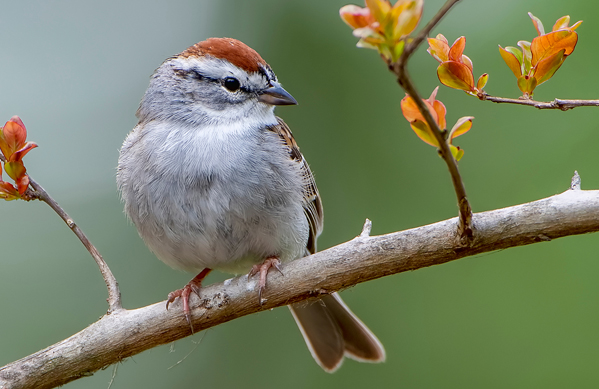About the House Wren
As implied by its common name, the small, active House Wren is often found near people's homes. This bird's genus name Troglodytes means "hole dweller," and refers to its mouse-like tendency to pop in and out of crevices while foraging and seeking shelter or nesting spots.
Smaller and plainer than the related Carolina Wren, the House Wren is grayish-brown, with subtle barring on its wings, back, and tail, and a light (not white) eyeline. Both sexes look alike. Like other wrens, the House Wren often carries its tail cocked up at a jaunty angle.
The House Wren, like another common backyard bird, the Blue Jay, seems to be loved and reviled in equal measure by its human neighbors.
Territorial Trials
Although many birds fiercely defend their territories during the breeding season, the House Wren takes this behavior to an extreme. The small songbird invades the cavity nests of neighboring species including the Eastern Bluebird, Prothonotary Warbler, Tree Swallow, and even other House Wrens to pierce (pip) eggs, throw young birds out of their nests, or sometimes fiercely peck nestlings and even adults to death. Males will also stuff cavities with twigs to keep other birds from nesting there.
Territorial House Wrens even attack the open-cup nests of species such as the Gray Catbird and American Robin. Larger birds readily chase House Wrens, which suggests that they recognize the threat the smaller birds pose.
Although the House Wren's aggressive behavior may shock human bystanders, it allows this small bird to gain an edge in the often-fierce competition for nesting space.
Songs and Sounds
Outsized Song
The loud, bubbly song of the House Wren seems larger than the singer itself! The Chippewa call it O-du-na'-mis-sug-ud-da-we'-shi, meaning "big noise for its size." Males constantly vocalize while on territory; females also sing, but not as consistently. This wren also has a characteristic harsh, scolding call.
Listen here:
(Audio: Paul Marvin, XC584561. Accessible at https://xeno-canto.org/584561 · Christopher McPherson, XC599652. Accessible at https://xeno-canto.org/599652)
Breeding and Feeding
Ladies' Choice
Male House Wrens arrive on the breeding grounds first, establishing their territories by singing and building a number of "dummy" stick nests to attract a female. When a female decides to accept a male and his territory (female House Wrens do the choosing), her mate takes her on a tour of his pseudo-nests. When she accepts a nest, she finishes it by adding a soft lining of feathers, hair, moss, and rootlets.
Although usually monogamous, House Wren relationships can get complicated. A male may attract several females to nest in his territory, but may also sneak into other males' territories to mate with the females nesting there. Chicks in a clutch rarely all have the same genetic father.
In turn, a female House Wren may raise a second brood with a new mate, leaving the young from her first clutch for the male to raise. House Wrens typically raise two broods per season — quite often with different mates.
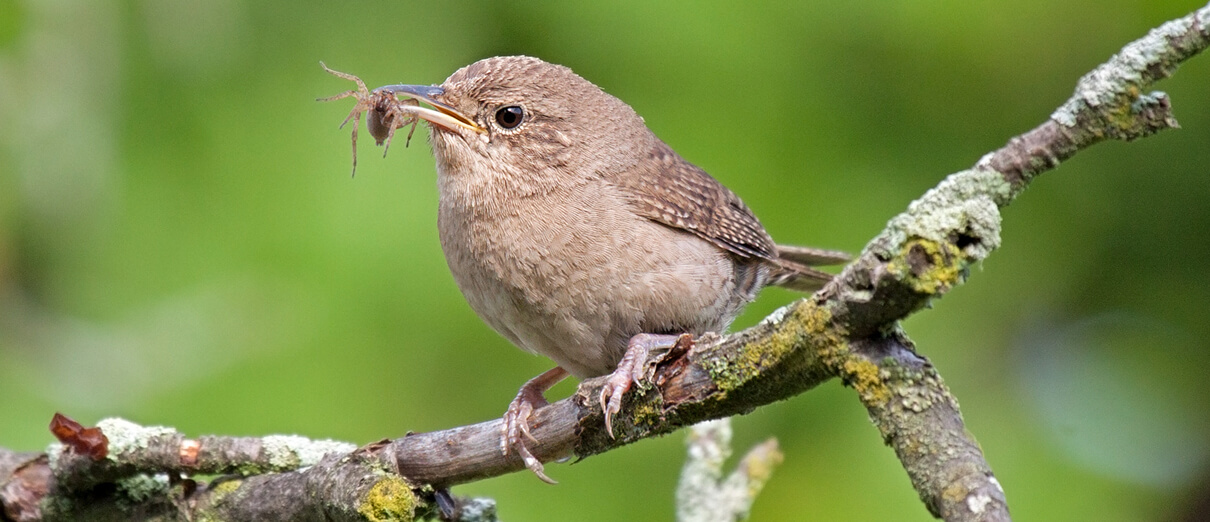
The House Wren is famous for nesting just about anywhere: in natural and artificial cavities, nest boxes of all types, planters and pots, drainpipes, shoes, and laundry left out to dry. John James Audubon, famous for his paintings of birds in their natural settings, painted a family of House Wrens nesting in an old hat!
The female lays a clutch of four to eight whitish-pink, brown-speckled eggs, which she incubates for about two weeks. Interestingly, House Wren eggs have unusually thick shells, and are almost twice as strong as similar-sized eggs. This unusual shell strength is likely an adaptation to this species' egg-destroying tendencies, which extend to their own kind.
Both parents help feed the hatchlings, which fledge after 12 to 16 days.
Insect-loving Wren
Unlike the more omnivorous Carolina Wren, the House Wren sticks with an all-insect diet, which is why birds of most U.S. and Canadian nesting populations must migrate south when winter arrives. This wren forages in thick vegetation and on the ground for all sorts of insects, including grasshoppers, crickets, ants, caterpillars, and moths, and other invertebrates such as spiders and snails.
Region and Range
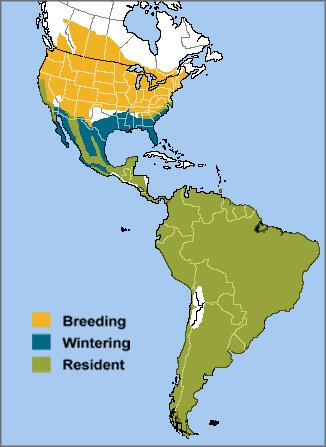
The House Wren is one of the most widely distributed native songbirds in the Americas, breeding from Canada to the southern tip of South America. A whopping 31 subspecies are recognized, further divided into five groups. Some subspecies are endemic to individual Caribbean islands, including Cozumel and Grenada. Several of these island subspecies differ so greatly in size and coloration from mainland forms that there is active debate about whether or not they are separate species.
After nesting season, most U.S. and Canadian House Wren populations migrate to the southern United States and Mexico for the winter. (The species is present year-round in much of California, in parts of southern Arizona, and along the southeastern edge of the breeding range.) House Wrens are believed to be nocturnal migrants, and more remains to be discovered on the exact routes and timing of their movements. Populations in Latin America are mainly resident.
Conservation of the House Wren
Like the American Goldfinch and Chipping Sparrow, the House Wren adapts well to suburban habitats, as long as there is ample cover including shrubs and tangles. Although its numbers remain stable, this species faces many of the same threats as less-adaptable birds. Many migrating House Wrens are killed in collisions with buildings, communications towers, and cars. As insectivores, they are also vulnerable to the direct and cumulative effects of pesticides.
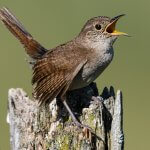
Help support ABC's conservation mission!
ABC has initiatives in place to tackle these threats, including our Glass Collisions program, which offers solutions to keep birds from hitting windows. Our Pesticides program continues to fight the worst of these toxins; we are pushing the U.S. Environmental Protection Agency (EPA) to require more review of dangerous chemicals, and demanding more accountability for pesticide manufacturers.
Get Involved
Policies enacted by the U.S. Congress and federal agencies, such as the EPA and U.S. Fish and Wildlife Service, have a huge impact on migratory birds. You can help shape these rules for the better by telling lawmakers to prioritize birds, bird habitat, and bird-friendly measures. To get started, visit ABC's Action Center.
Living a bird-friendly life can have an immediate impact on migratory birds in the United States. Doing so can be as easy as adding native plants to your garden, avoiding pesticides, and keeping cats indoors. To learn more, visit our Bird-Friendly Life page.
American Bird Conservancy and our Migratory Bird Joint Venture partners have improved conservation management on more than 6.4 million acres of U.S. bird habitat — an area larger than the state of Maryland — over the last ten years. That's not all: With the help of international partners, we've established a network of more than 100 areas of priority bird habitat across the Americas, helping to ensure that birds' needs are met during all stages of their lifecycles. These are monumental undertakings, requiring the support of many, and you can help by making a gift today.





































